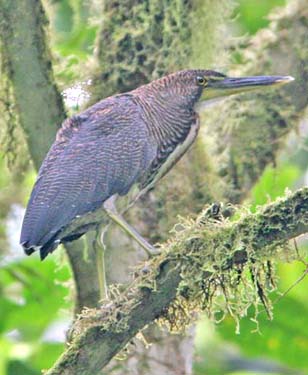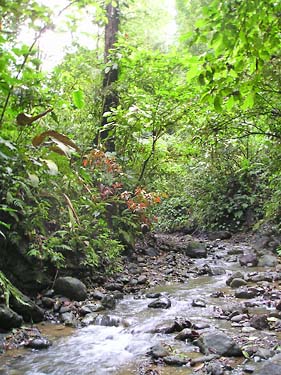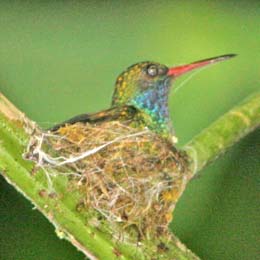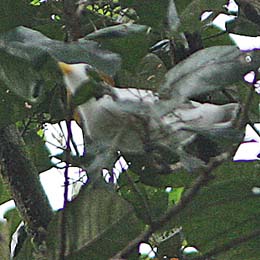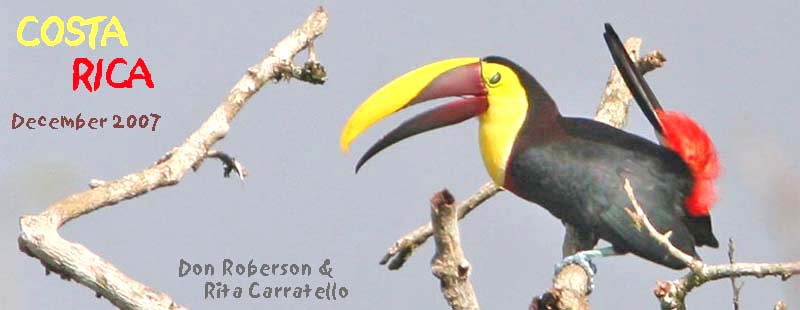

We stayed 4 nights at Bosque del Rio Tigre, an ecolodge operated by Liz & Abraham Gallo at the very edge in the rainforest (right). It is at 130m (425') near the boundary of the vast Corcovado National Park. The lodge bird list has 358 species, and many of them have been observed from the lodge itself. Getting there is an adventure, with two river crossings (that's our taxi crossing the Rio Tigre to leave the lodge, below). |
||||||||||||||||||
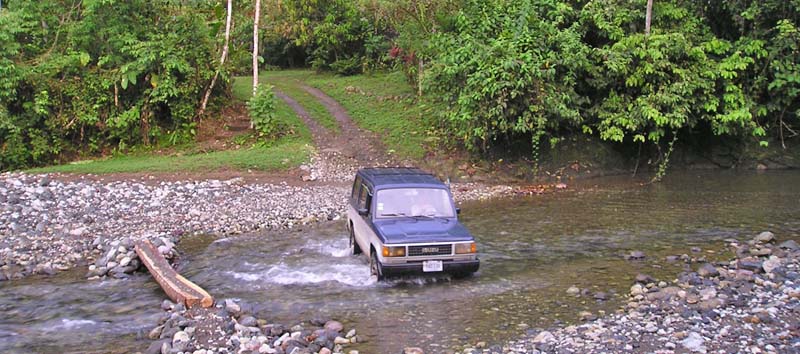 |
||||||||||||||||||
Because it is open to outside, there are geckos hiding behind jars in the pantry [see herp page], an occasional bat will land on the ceiling at night [see mammal page], and one can easily watch the feeders out front and out back from the comfortable chairs. Indeed, there is yet another 'feeder' just beyond the kitchen shown at left. Rice is thrown out daily at the edge of the forest, and it attracts birds all day. The shots below were taken from the kitchen: a Gray-necked Wood-Rail (below left) and a Little Tinamou (below right). There are very few spots in the world were either wood-rails or tinamous are feeder birds! |
||||||||||||||||||
|
||||||||||||||||||
As the lodge itself was booked when we planned our trip, we reserved the small cabana about 25m from the lodge, and completely surrounded by forest (right & below). It was bright and airy, with half-walls and no windows, but a good mosquito-net over the bed. It had 24-hour electricity and a private bath with cold water; a fine hot-water shower, run by solar power, was a few steps away outside the lodge. It was a treat to listen to the sounds of the night and the dawn chorus from our bed. On our final morning, a troop of White-faced Capuchin were the 'alarm clock' [see mammal page]. I would love to return for a longer visit. |
||||||||||||||||||
|
||||||||||||||||||
|
||||||||||||||||||
 |
||||||||||||||||||
|
||||||||||||||||||
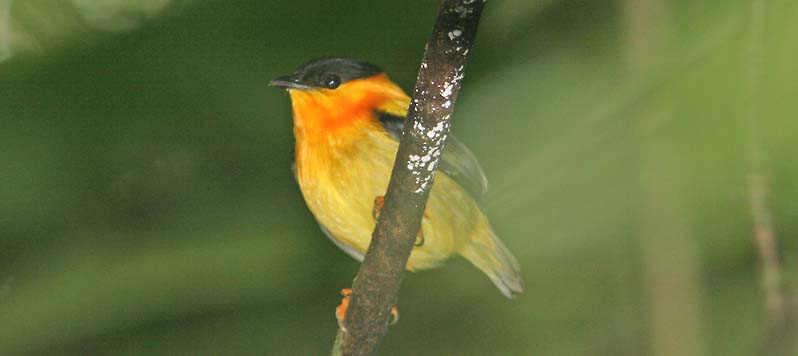 |
||||||||||||||||||
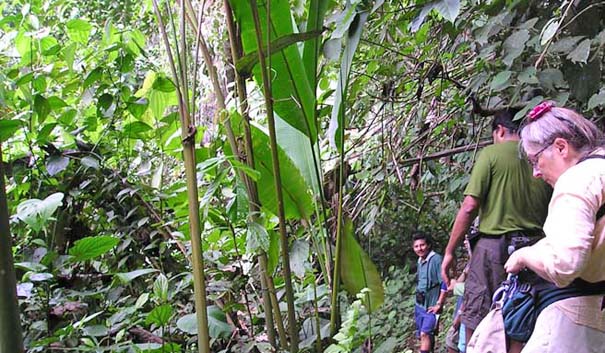 I
enjoyed spending as much time inside the forest as I could.
Occasionally we would go with others to see a highlight [in this photo,
right, there is an Eyelash Viper; close-up on Herp page],
but often it was just Rita and me, or me alone. The gallery of photos
below is a selection of shots from inside the forest, primarily using
the built-in flash in my Canon digital camera. I
enjoyed spending as much time inside the forest as I could.
Occasionally we would go with others to see a highlight [in this photo,
right, there is an Eyelash Viper; close-up on Herp page],
but often it was just Rita and me, or me alone. The gallery of photos
below is a selection of shots from inside the forest, primarily using
the built-in flash in my Canon digital camera. |
||||||||||||||||||
|
||||||||||||||||||
You've also got to love a place where you can sit by the river, morning or afternoon, and watch brilliant flights of Scarlet Macaw screech by (below). |
||||||||||||||||||
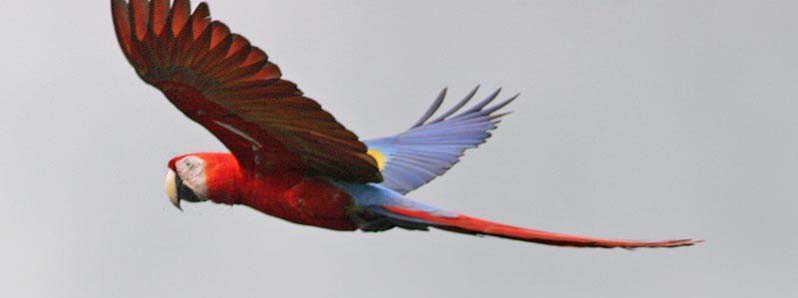 |
||||||||||||||||||
|
||||||||||||||||||
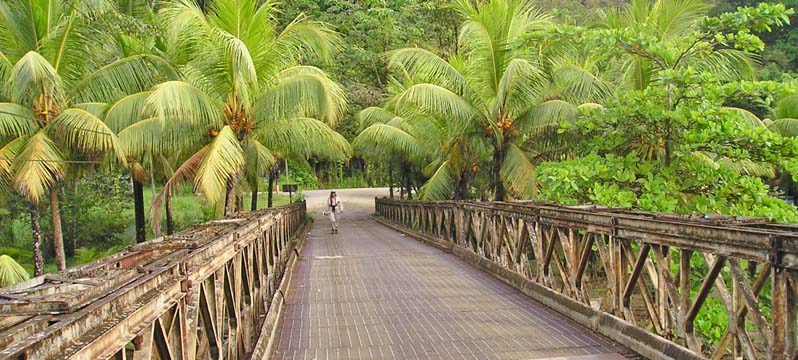 |
||||||||||||||||||
| Several Mangrove Swallow (left) were perched on the wire next to the bridge, and several important birds were found here or nearby. Luis spotted an active nest of Blue-tailed Goldenthroat (below left). We also found several Yellow-billed Cotinga (below center) either perched at the tops of tall, bare trees, or feeding on small fruit in the forest canopy next to the road. This was one of my most sought-after species on the trip. I also digiscoped a young Bare-throated Tiger-Heron (below right). All in all, a nice conclusion to our trip. | ||||||||||||||||||
|
||||||||||||||||||
INTRODUCTION TO COSTA RICA TRIP Dec 2007 |
|
Atlantic Lowlands LA SELVA |
|
Montane Cloud Forest SAVEGRE |
HERPS Reptiles & Amphibians |
Pacific Lowlands RIO TIGRE |
ODES Dragonflies & Damselflies |
Complete TRIP LIST with birds, mammals & herps |
|
page created 23-25 Jan 2008
|
© Don Roberson |
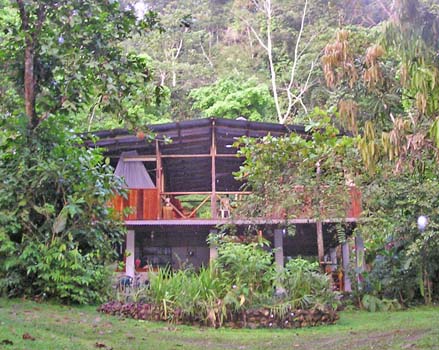 Ever
since my first brief visit to Costa Rica in 1989, I have wanted to
return and see the Osa Peninsula. This peninsula is well down the
Pacific side, near the Panama border. Two of the country's three
endemic birds occur only here or nearby. The photo (above) is a view of
the Osa Peninsula from the mainland, separated by the Golfo Dulce.
Ever
since my first brief visit to Costa Rica in 1989, I have wanted to
return and see the Osa Peninsula. This peninsula is well down the
Pacific side, near the Panama border. Two of the country's three
endemic birds occur only here or nearby. The photo (above) is a view of
the Osa Peninsula from the mainland, separated by the Golfo Dulce. 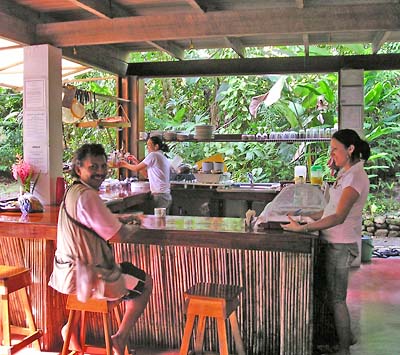 Everything
about the design of the Rio Tigre lodge serves to enhance the forest
experience. While solid roofs protect all buildings, most are without
walls and open to outside, like the kitchen bar (left; that's Abraham
with two of the friendly staff who prepared great meals). The second
floor, above this kitchen and dining floor, does have enclosed rooms
for tourists.
Everything
about the design of the Rio Tigre lodge serves to enhance the forest
experience. While solid roofs protect all buildings, most are without
walls and open to outside, like the kitchen bar (left; that's Abraham
with two of the friendly staff who prepared great meals). The second
floor, above this kitchen and dining floor, does have enclosed rooms
for tourists. 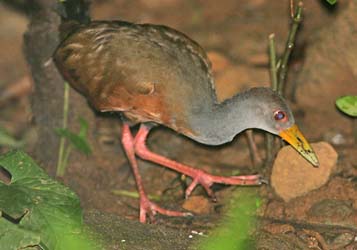
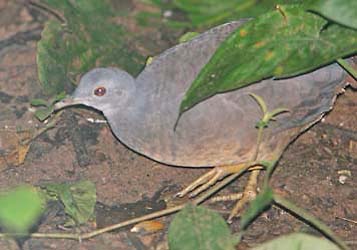
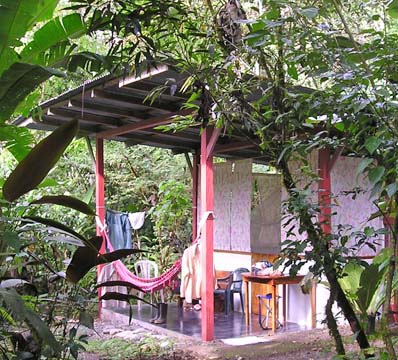
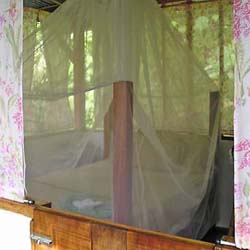
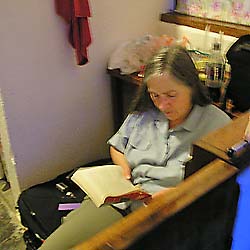
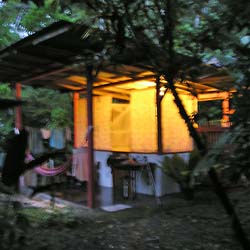
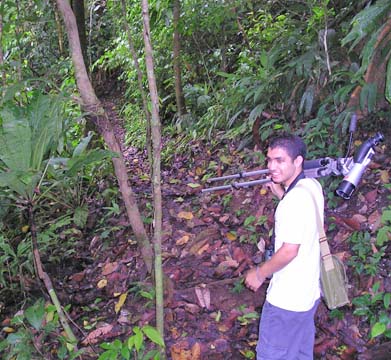
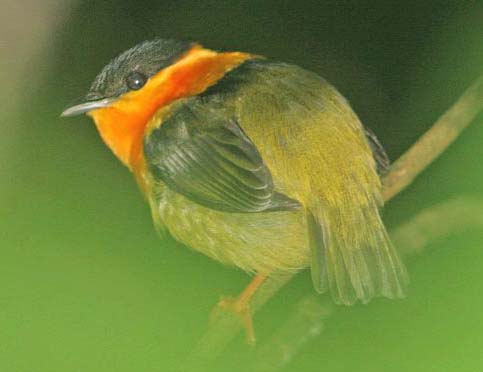
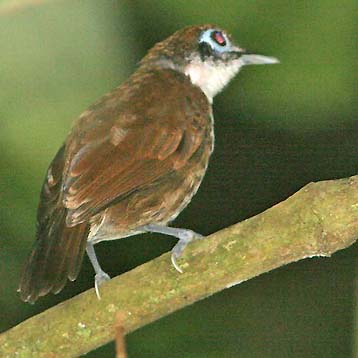
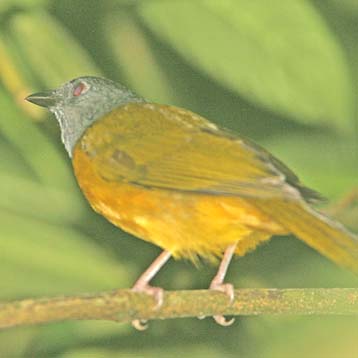
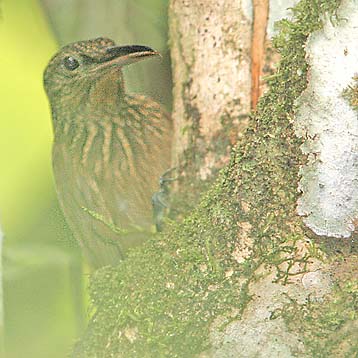
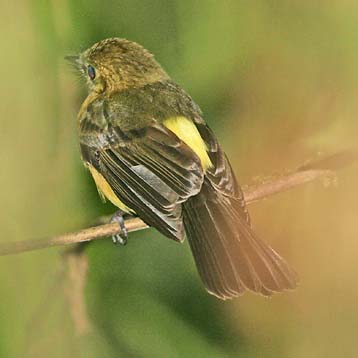
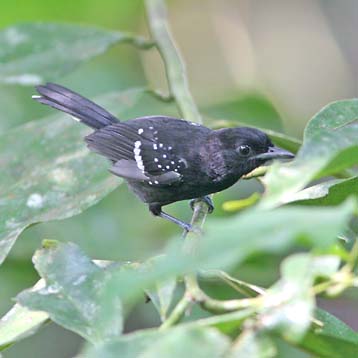
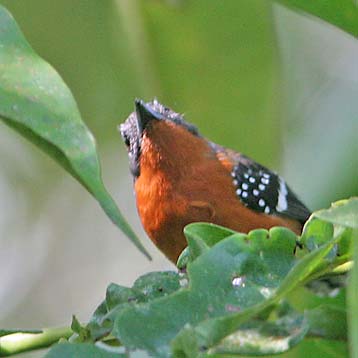
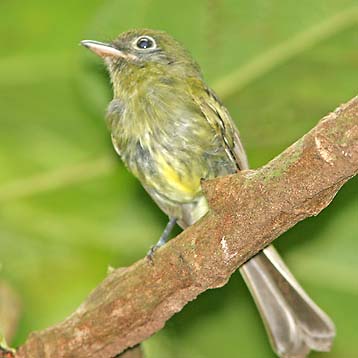
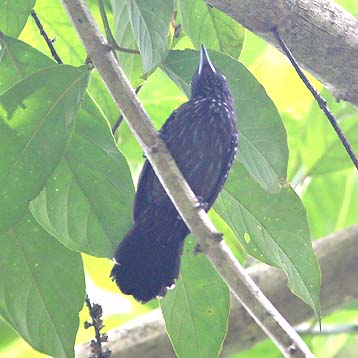
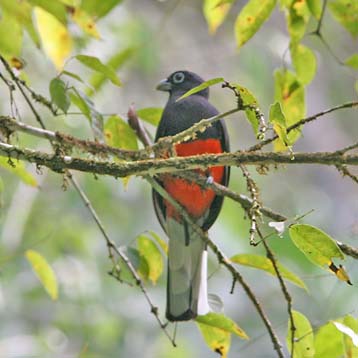

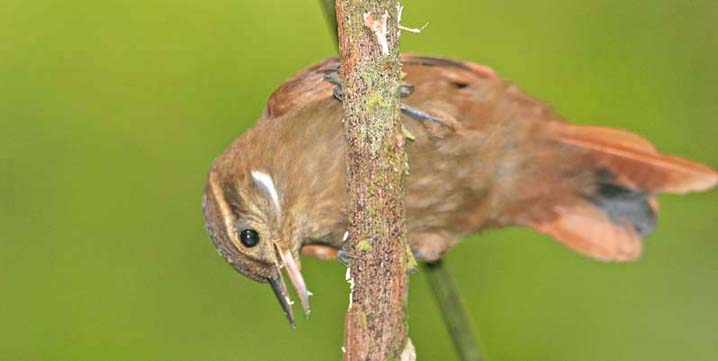
 Throughout
our visit, when not otherwise engaged, Abraham kept an eye on the tall
fruiting tree with a bare-branch canopy, across the river, where
cotingas sometimes sit. He had a scope constantly set up. A one
afternoon, for a few brief moments, two female Turquoise Cotinga did land! I tried a digiscoped shot through the scope — not great but still identifiable (right).
Throughout
our visit, when not otherwise engaged, Abraham kept an eye on the tall
fruiting tree with a bare-branch canopy, across the river, where
cotingas sometimes sit. He had a scope constantly set up. A one
afternoon, for a few brief moments, two female Turquoise Cotinga did land! I tried a digiscoped shot through the scope — not great but still identifiable (right). 